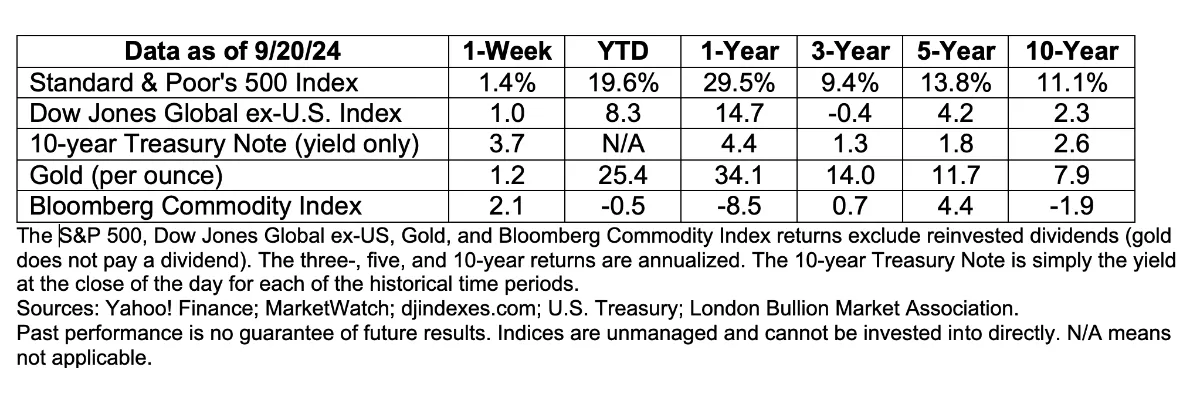Sept 23, 2024
The Markets
Rates moved lower and stocks moved higher.
In 2022, the United States Federal Reserve (Fed) began raising interest rates as it battled high rates of inflation. That year prices rose 8 percent, as measured by the Consumer Price Index. In 2023, prices increased more slowly (4.1 percent), but still advanced at a pace that was well above the Fed’s target of two percent. Last month, prices rose 2.5 percent annualized. And last week, the Fed decided it is time to change course.
“On Wednesday, policymakers indicated their rate cut would likely be the first of several through the end of next year. The median forecast among members of the Federal Open Market Committee was that the benchmark federal-funds rate will be at 3.4 [percent] by the end of 2025, compared with the current targeted range of 4.75 [percent] to 5 [percent],” reported Elizabeth O’Brien and Shaina Mishkin of Barron’s. “This marks a significant shift. The Fed has moved from a phase when it kept rates high to combat inflation to one where it is lowering them to support the labor market and the broad economy.”
As borrowing costs move lower, other interest rates are likely to follow. As a result, consumers, investors, and business owners may have opportunities to:
• Pay lower interest rates on auto and home loans,
• Refinance mortgages at lower rates, and
• Tap into home equity at a lower cost.
Major U.S. stock indices rose on Thursday, following the Fed’s rate cut. “The S&P 500 climbed 1.7 [percent]—notching its 39th record in 2024 and extending this year’s surge to about 20 [percent],” reported Rita Nazareth of Bloomberg. “The Fed’s bold start to cutting interest rates and its determination not to fall behind the curve re-ignited hopes the central bank will be able to avoid a recession. Data Thursday showing a slide in jobless claims to the lowest since May signaled the labor market remains healthy despite a slowdown in hiring.”
Stocks gave back some gains on Friday but finished week higher. Yields on U.S. Treasuries were mixed over the week.

Disclosures and resources:
* These views are those of Carson Coaching, not the presenting Representative, the Representative’s Broker/Dealer, or Registered Investment Advisor, and should not be construed as investment advice.
* This newsletter was prepared by Carson Coaching. Carson Coaching is not affiliated with the named firm or broker/dealer.
* Government bonds and Treasury Bills are guaranteed by the U.S. government as to the timely payment of principal and interest and, if held to maturity, offer a fixed rate of return and fixed principal value. However, the value of fund shares is not guaranteed and will fluctuate.
* Corporate bonds are considered higher risk than government bonds but normally offer a higher yield and are subject to market, interest rate and credit risk as well as additional risks based on the quality of issuer coupon rate, price, yield, maturity, and redemption features.
* The Standard & Poor’s 500 (S&P 500) is an unmanaged group of securities considered to be representative of the stock market in general. You cannot invest directly in this index.
* All indexes referenced are unmanaged. The volatility of indexes could be materially different from that of a client’s portfolio. Unmanaged index returns do not reflect fees, expenses, or sales charges. Index performance is not indicative of the performance of any investment. You cannot invest directly in an index.
* The Dow Jones Global ex-U.S. Index covers approximately 95% of the market capitalization of the 45 developed and emerging countries included in the Index.
* The 10-year Treasury Note represents debt owed by the United States Treasury to the public. Since the U.S. Government is seen as a risk-free borrower, investors use the 10-year Treasury Note as a benchmark for the long-term bond market.
* Gold represents the 3:00 p.m. (London time) gold price as reported by the London Bullion Market Association and is expressed in U.S. Dollars per fine troy ounce. The source for gold data is Federal Reserve Bank of St. Louis (FRED), https://fred.stlouisfed.org/series/GOLDPMGBD228NLBM.
* The Bloomberg Commodity Index is designed to be a highly liquid and diversified benchmark for the commodity futures market. The Index is composed of futures contracts on 19 physical commodities and was launched on July 14, 1998.
* The DJ Equity All REIT Total Return Index measures the total return performance of the equity subcategory of the Real Estate Investment Trust (REIT) industry as calculated by Dow Jones.
* The Dow Jones Industrial Average (DJIA), commonly known as “The Dow,” is an index representing 30 stock of companies maintained and reviewed by the editors of The Wall Street Journal.
* The NASDAQ Composite is an unmanaged index of securities traded on the NASDAQ system.
* International investing involves special risks such as currency fluctuation and political instability and may not be suitable for all investors. These risks are often heightened for investments in emerging markets.
* Yahoo! Finance is the source for any reference to the performance of an index between two specific periods.
* The risk of loss in trading commodities and futures can be substantial. You should therefore carefully consider whether such trading is suitable for you in light of your financial condition. The high degree of leverage is often obtainable in commodity trading and can work against you as well as for you. The use of leverage can lead to large losses as well as gains.
* Opinions expressed are subject to change without notice and are not intended as investment advice or to predict future performance.
* Economic forecasts set forth may not develop as predicted and there can be no guarantee that strategies promoted will be successful.
* Past performance does not guarantee future results. Investing involves risk, including loss of principal.
* The foregoing information has been obtained from sources considered to be reliable, but we do not guarantee it is accurate or complete.
* There is no guarantee a diversified portfolio will enhance overall returns or outperform a non-diversified portfolio. Diversification does not protect against market risk.
* Asset allocation does not ensure a profit or protect against a loss.
* Consult your financial professional before making any investment decision.
* To unsubscribe from the “Enter the name of your commentary” please click here or write us at “Your Address Here”.
* To unsubscribe from the “Enter the name of your commentary” please reply to this email with “Unsubscribe” in the subject line or write us at “Your Address Here”.
https://home.treasury.gov/resource-center/data-chart-center/interest-rates/TextView?type=daily_treasury_yield_curve&field_tdr_date_value=2024








